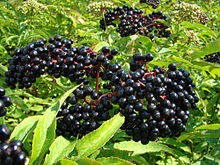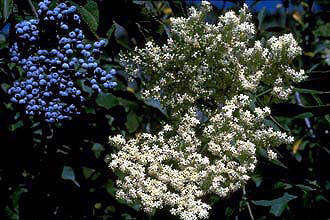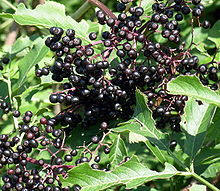
Elderberry U-Pick Orchards in Ontario in 2025, by area of state
Keep in mind, not all areas of any state, nor even every state, have elderberries orchards that are open to the public. If you know of any others, please tell us using the add a farm form!
These are the areas of the state that have elderberry orchards to pick elderberries. Click on the area closet you!
Elderberry
Elderberry Picking Tips, Recipes and Information

In the U.S. Elderberries typically peak during June in the South, and in July in the North. Crops are ready at various times of the month depending on which part of the state you are located. In order to produce good local Elderberries, producers depend on ideal spring and early summer weather conditions. See this page for a list of elderberry festivals around the U.S.
Before you leave to go to the farm:
- Always call before you go to the farm - And when they are in season, a large turnout can pick a field clean before noon, so CALL first!
-
Leave early. On weekends, then fields may be picked out!
-
Most growers furnish picking containers designed for Elderberries, but they may charge you for them; be sure to call before you go to see if you need to
bring containers.
If you use your own containers, remember that heaping Elderberries more than 5 inches deep will bruise the lower berries. Plastic dishpans, metal oven pans with 3 inch tall sides and large pots make good containers. I like the Glad storage containers like the one at right. - Bring something to drink and a few snacks; you'd be surprised how you can work up a thirst and appetite! And don't forget hats and sunscreen for the sun. Bugs usually aren't a problem, but some deet might be good to bring along if it has been rainy.
When
- Elderberries are best picked when they are fully ripe, the harvest season is usually in late summer to early fall.
- Look for clusters of berries that are dark purple or black in color. Avoid picking unripe green berries.
Picking wild elderberries
If there isn't a farm near you, they may be growing wild in your area. Old-timers and county extension agents may know where.
- Elderberry bushes can be found in various habitats, including roadsides, fields, and forest edges.
- Ensure you are picking from an area free of pollutants, pesticides, and contaminants.
- Familiarize yourself with the appearance of elderberry bushes, characterized by their opposite leaf arrangement and distinctive compound leaves. Remember that proper identification and responsible harvesting practices are crucial when foraging for any wild plants. If you're uncertain about the plants you're picking, it's best to consult with a knowledgeable local expert before consuming or using them.
- Make sure you can distinguish elderberries from similar-looking plants, such as red elderberries, which are toxic.
- Only pick berries from abundant stands, leaving enough for local wildlife and for the plant to reproduce.
- Be mindful of the surrounding ecosystem and avoid damaging plants or disturbing wildlife.
Preparation
- Wear Proper Gear: Wear long sleeves, pants, and gloves to protect your skin from potential irritations caused by leaves and stems.
- Bring a pair of pruning shears or scissors for easier berry removal.
How to pick
- Choose plump, fully ripe berries that are free from mold, insects, and damage.
- Berries should be firm and evenly colored.
- Gently hold the berry cluster and snip the stem with your pruning shears or scissors.
- Be careful not to shake the cluster excessively, as overripe berries can fall off easily.
After harvesting
- Avoid placing the picked berries in the sunlight any longer than necessary. It is better to put them in the shade of a tree or shed than in the car trunk or on the car seat. Cool them as soon as possible after picking.
- Store freshly picked elderberries in a shallow container, preferably in a single layer, to prevent crushing.
- Keep them refrigerated and use within a few days, or freeze them for longer storage.
- Before using elderberries, remove them from their stems using a fork or by gently combing through with your fingers.
- Elderberries can be used for making jams, jellies, syrups, wines, and more.
- Safety Note: Elderberries should not be consumed raw in large quantities as they contain compounds that can cause digestive
discomfort. Cooking or properly preparing them eliminates these concerns.
Elderberry Recipes, Freezing and Jam directions
If you'd like to make some elderberry foods, see these pages for directions:
- Canning elderberries
- Canning elderberry juice
- Freezing elderberries
- Elderberry pie
- Elderberry syrup, make and can it!
- Juicers make the job a lot easier!
- Here are some useful, fun and interesting facts about elderberries
- Elderberry Festivals: Where, When and More to Find an Elderberry Festival Near You this year:
Other Local Farm Products (Honey, Horses, Milk, Meat, Eggs, Etc.)
(NOT pick-your-own, unless they are also listed above)
- Farm markets and roadside stands
- Local Honey Finder
- Local Meat, Milk and Eggs
- Venues: Farms, Wineries, Orchards for your event, wedding or party
- Easter egg hunts
- Children"s consignment sales
- Fruit and vegetable festivals
- Winery tours and wine tastings
- Horse rides, stables, lessons, trails
- Maple Syrup farms and sugarworks
- Bed & Breakfasts on Farms, Wineries, Ranches and Orchards
- Pumpkin patches
- Corn mazes
- Zombie Paintball venues
- Christmas Tree Farms & lots
- Environmental resources
- Consumer fraud information
- Wholesale food sources
- Resources for Farmers
Looking for canning equipment and supplies?
Water bath canner with a jar rack
Pressure canners for gas, electric and induction stoves: Presto 23Qt or T-fal 22Qt
Canning scoop (this one is PERFECT)
Ball Blue book (most recent version)
Jars: 8oz canning jars for jams
Find Other types of farms:
Farm markets and roadside stands
Road trips and camping resources
Local Honey, apiaries, beekeepers
Consumer fraud and scams information
Home canning supplies at the best prices on the internet!
Maple Syrup Farms, sugarworks, maple syrup festivals
Environmental information and resources
Farms For Your Event for birthday parties, weddings, receptions, business meetings, retreats, etc.
Festivals - local fruit and vegetable festivals
Get the
most recent version of
the Ball Blue Book
With this Presto 23 quart pressure canner and pressure cooker, you can "can" everything, fruits, vegetables, jams, jellies, salsa, applesauce, pickles, even meats, soups, stews. Model 01781

You can make jams, jellies, can fruit, applesauce, salsa and pickles with water bath canners, like this Granite Ware 12-Piece Canner Kit, Jar Rack, Blancher, Colander and 5 piece Canning Tool Set

